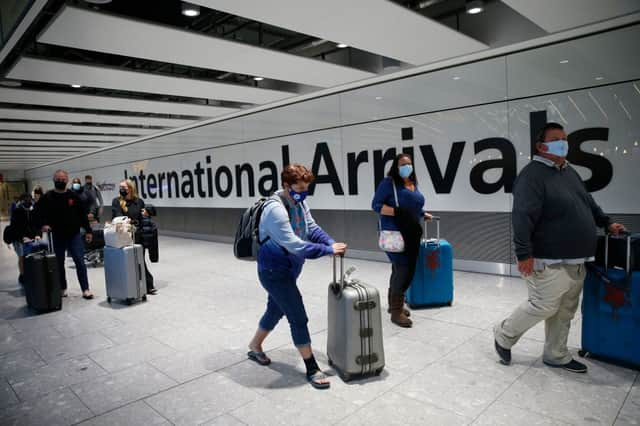20,000 passengers could have spread Indian Covid variant in UK after travel to India


More than 20,000 passengers may have spread the Indian Covid variant after arriving in the UK from India.
Public Health England (PHE) has said almost half of all cases are related to travel or contact with a traveller.
Advertisement
Hide AdAdvertisement
Hide AdBoris Johnson delayed imposing a travel ban to the country until 23 April when India was added to the UK’s ‘red list’, but this was almost a month after the variant was first detected in the country.
Borders not closed in time
Ministers have been accused of failing to close the UK’s borders in time to stop the variant from entering the country, despite Covid cases spiralling out of control in India in late March.
Coronavirus infections more than tripled in India from 72,330 on 31 March, to a huge 217,353 on 15 April, yet the country was not added to the red list until a week later.
Mr Johnson had hoped to travel to Delhi on 25 April to meet with Indian Prime Minister Narendra Modi to discuss post-Brexit trade. However, the trip was later called off on 19 April after hospitalisations began to surge.
Advertisement
Hide AdAdvertisement
Hide AdShortly after this, Health Secretary Matt Hancock announced in the House of Commons that India would be placed on the red list, but the measure was not implemented until 23 April, despite the government’s insistence countries could be added to the list with just a few hours notice.
Travel website Skyscanner reported a 250 per cent increase in searches for flights after the announcement was made as families scrambled to return to the UK before the measure took effect.
Figures from the Civil Aviation Authority show an average of 900 people arrived in the UK from India between 2 April and 23 April, with more than 20,000 people entering the country overall during this period.
The Indian variant was first detected in a traveller who arrived from India in the week ending 29 March.
Advertisement
Hide AdAdvertisement
Hide AdData from PHE shows at least 122 travellers arriving from Mumbai and Delhi between the end of March and 26 April were carrying the strain, which was not designated a “variant of concern” until 7 May.
A source involved in discussions over how to prevent the variant’s spread in the UK told the Sunday Times: “It’s very clear that we should have closed the border to India earlier and that Boris did not do so because he didn’t want to offend Modi.”
Matt Hancock defended the timing of when the Government put India on the travel “red list” although sidestepped questions on whether the decision was linked to Prime Minister Boris Johnson’s planned – and then postponed – trip to the country.
The Health Secretary told Sky News: “This variant was notified as a variant under investigation after we’d already put India on the red list. The decision to put India on the red list was taken because of the high positivity rate of people coming from India and looking at the epi-curve in India.
Advertisement
Hide AdAdvertisement
Hide Ad“When we put Pakistan on the red list at the start of April that’s because the proportion of people testing positive coming in from Pakistan was three times higher the proportion coming from India, and it was only after we put India on the red list that this variant went under investigation, and then earlier this month it became a variant of concern.”
Asked about the impact of Mr Johnson’s planned trip to India in late April in a bid to assist trade talks, Mr Hancock replied: “We take these decisions based on the evidence.”
Should Monday’s easing be delayed?
Ministers have decided to push on with a major easing of restrictions in England on Monday (17 May) despite concerns over the Indian variant, which scientists have warned may be 50 per cent more transmissible than other strains.
The Scientific Advisory Group for Emergencies (Sage) said if the higher transmissibility is confirmed, moving to step three of the lockdown road map could “lead to a substantial resurgence of hospitalisations” that is “similar to, or larger than, previous peaks”.
Advertisement
Hide AdAdvertisement
Hide AdHowever, health minister Edward Argar said on Saturday (15 May) that the government was acting “coolly” and “calmly” in carrying on with step three, which will allow mixing indoors, greater physical contact and foreign holidays to a limited number of countries.
Mr Argar told BBC Breakfast: “All the evidence so far suggests there is no evidence of increased severity of illness or that it evades the vaccine.
“So, at the moment, on the basis of the evidence we are doing the right thing, coolly, calmly continuing with Monday, but keeping everything under review.
“You have to take all the facts into consideration. It’s about personal responsibility, it’s about making the right judgment call.”
Advertisement
Hide AdAdvertisement
Hide AdThe British Medical Association (BMA) said the move is a “real worry” while many are still awaiting vaccination.
Public health medicine committee co-chairman Dr Richard Jarvis urged the public to take a “cautious approach” to social and physical contact.
He said: “With key segments of the population still not vaccinated and clusters of variants, including the rapidly increasing Indian variant, becoming a growing concern, we must approach this next stage of easing lockdown with the utmost caution.
“It is a real worry that when further measures lift on May 17, the majority of younger people, who are often highly socially mobile and could therefore be most at risk of a more infectious strain, are not yet vaccinated.”